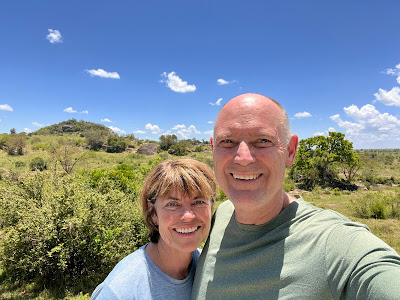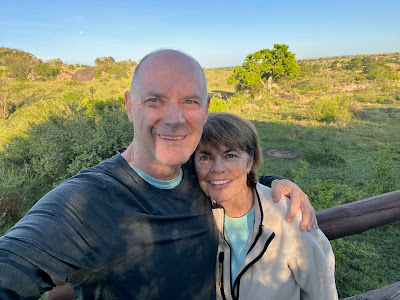Our journey to Africa spanned 10,000 miles and with a long layover, about 24 hours each way. It also seemed to take us back in time – like the Way Back Machine in the old Rocky and Bullwinkle cartoons of my youth.
The parts of Africa we saw – aside from Arusha, Tanzania’s third-largest
city into which we flew – are like a place time forgot. There are, of course, some
paved main roads, vans and trucks, and we often had access to the Internet,
even in very remote areas. But so much seems nearly untouched by modern
influence:
- The vast expanses of ancient trees, unmolested game animals and birds, and virgin landscapes that stretch to the faraway horizon, seem unchanged since prehistoric times.
- The Industrial Revolution doesn’t seem to have reached much of the country.
- Tribes such as the nomadic Maasai retain a culture and customs from millennia ago.
Unspoiled nature
About 38 percent of Tanzania – 16,000 square miles – is composed of national parks, preserves, marine parks, and a large conservation area, and much of the rest is undeveloped.
Two of our lodges were rustic affairs set deep within the parks, right among the animals’ habitat and accessible only by sturdy four-wheel-drive vehicles along primitive paths.
They are designed to blend in with the otherwise pristine environs, and to disrupt nature as little as possible. At one camp, our accommodation was a “tree house,” a cabin built fifteen feet off the ground in a tree (to keep us safe from roaming predators); at the other our home was a large, drab-colored tent, from where we heard a lion attack a buffalo one night and during the day were visited by buffalo, zebras and elephants just steps away from us.
Lack of mechanization
Across the portions of the country we saw, in the north and east, there was little mechanization, other than the legions of “Chinese Gazelles,” or motor bikes, that idle teenage boys straddle. People with hoes, not tractors, till the soil. Crops are carried to market not, for the most part, by truck, but on the heads of women or in carts pulled by ox or donkeys. Villages often do have a row of cinder-block shacks with metal or thatched roofs that house markets, bars, and the like, similar to our suburban strip centers. But the living quarters within the often-walled villages, are tiny and appear to not have electricity, indoor plumbing, or windows.
Tanzania has a rich culture built over thousands of years, and
the people we encountered were incredibly warm, friendly, and seemingly joyful.
Many elements of their culture do not align with our sensibilities, however. Women,
for instance, do not have equal status to men. Polygamy is legal; men may have
up to four wives, although women may not have multiple husbands. And many
marriages are arranged for girls at an early age. In addition, people with
disabilities are shunned in the country, and this is reflected in school
attendance data. The government estimates that roughly 8 percent of children have
disabilities, yet only about 1 percent of disabled children attend school.
There are more than 120 tribes, or what Wikipedia calls ethnic groups, in Tanzania, each with its own ancient language and customs. English and Swahili are taught in school to overcome the communications barrier.
The Maasai
One of the largest tribes is the nomadic Maasai people. These herders travel across Tanzania and Kenya with their cattle or goats using a vast network of prehistoric-looking villages that are comprised of thatched huts, animal pens, and a circular area for ceremonies called a boma. They drive their herds to grazing sites, either on land dedicated to them or on privately held land that can sometimes cause disputes. We visited a market where farming tribes and Maasai meet to buy and sell livestock, vegetables, textiles, and the like.
Sidebar: Our remarkable guide director, Joseph Mushi, had begun an informal awarding of points for us safarists (I made up that word) when we were the first to spot a game animal. The others in our group were racking up points, but I was stuck on zero. As we drove along (in an area where there surely were no lions), I briefly spotted out of the corner of my eye a partially hidden animal with the tawny hide of a lion. “Lion!” I exclaimed, proud of my sighting. As the word left my mouth a herd of cattle lazily meandering ahead of a Maasai shepherd appeared; I had mistaken a cow for a lion. I was henceforth known by my colleagues as Lion King.
The Maasai are recognizable by their colorful, long-flowing garments, called shúkà, stretched earlobes, piercings, and ornate jewelry. Many retain ancient customs and ways of life: Their diet is dominated by their livestock: They mainly consume beef, milk and cow’s blood. They live in primitive huts.
The central human figure in the Maasai religious system is the laibon, whose roles include shamanistic healing, divination and prophecy, and ensuring success in war or adequate rainfall, according to Wikipedia.
Rites of passage
Passing to adulthood in Maasai culture is also steeped in old customs. Until recently, boys were sent out to kill a lion. Upon achieving that, they were circumcised and expected to not flinch during the procedure. Lions can no longer be killed (unless they attack a herd), but the circumcision rite remains. Girls nearing adulthood undergo “excision,” or genital mutilation. The Maasai believe that female circumcision “is necessary and Maasai men may reject any woman who has not undergone it as either not marriageable or worthy of a much-reduced bride price,” according to Wikipedia. For more about the Maasai, visit www.Maasaiwilderness.org.
Tanzania is one of the world’s poorest countries measured by
gross domestic product per capita, and we saw the endemic poverty in full force
on our rides between the four-star lodges we stayed in. If the disparity didn’t
make you feel at least uncomfortable, self-conscious, or embarrassed, you wouldn’t
be paying attention.
We talked at length with our colleagues about dilemmas
related to providing financial assistance: How do you help without interfering
with their way of life? Is there a moral imperative to speak out against what
we perceive to be abhorrent practices such as genital mutilation? Or are customs
and practices in other lands inviolate rights? Are we the self-appointed arbiters
of acceptable norms?
Heavy questions. I would love to know your thoughts.
Our trip to Africa was certainly a great highlight in my
life. Besides seeing the majestic and exotic animals we saw at extremely close
range in their own habitat, it opened my eyes to a world very different from my
own and gave me new perspective on many subjects. Donna and I met wonderful
people who will stay with us forever. And maybe, as Elphaba in Wicked
sings, I will have been changed for good.
Here are a few more pictures....


































Comments
Post a Comment